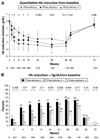Variants in the ITPA gene protect against ribavirin-induced hemolytic anemia and decrease the need for ribavirin dose reduction
- PMID: 20547162
- PMCID: PMC3086671
- DOI: 10.1053/j.gastro.2010.06.016
Variants in the ITPA gene protect against ribavirin-induced hemolytic anemia and decrease the need for ribavirin dose reduction
Abstract
Background & aims: In a genome-wide association study of patients being treated for chronic hepatitis C, 2 functional variants in ITPA that cause inosine triphosphatase (ITPase) deficiency were shown to protect against ribavirin (RBV)-induced hemolytic anemia during early stages of treatment. We aimed to replicate this finding in an independent cohort from the Study of Viral Resistance to Antiviral Therapy of Chronic Hepatitis C and to investigate the effects of these variants beyond week 4.
Methods: Genetic material was available from 318 patients. The ITPA variants, rs1127354 (exon 2, P32T) and rs7270101 (intron 2, splice altering), were genotyped and tested for association with hemoglobin (Hb) reduction at week 4. An ITPase deficiency variable was defined that combined both ITPA variants according to documented effect on ITPase activity. We investigated the impact of ITPA variants on Hb levels over the course of therapy and on the need for RBV dose reduction.
Results: The final analysis included 304 patients with genotype 1 hepatitis C virus (167 white patients and 137 black patients). The polymorphisms rs1127354 and rs7270101 were associated with Hb reduction at week 4 (P = 3.1 × 10(-13) and 1.3 × 10(-3), respectively). The minor alleles of each variant protected against Hb reduction. Combining the variants into the ITPase deficiency variable strengthened the association (P = 2.4 × 10(-18)). The ITPase deficiency variable was associated with lower rates of anemia over the entire treatment period (48 weeks), as well as a lower rate of anemia-related RBV dose reduction (hazard ratio, 0.52; P = .0037). No association with sustained virological response was observed.
Conclusions: Two polymorphisms that cause ITPase deficiency are strongly associated with protection from RBV-induced hemolytic anemia and decrease the need for RBV dose reduction.
Copyright © 2010 AGA Institute. Published by Elsevier Inc. All rights reserved.
Conflict of interest statement
Conflicts of interest
The authors disclose the following: A.J.T., J.F., D.G., T.J.U., K.V.S., D.B.G., and J.G.M. are coinventors of a patent application based on the ITPA discovery. K.P., H.L.T., S.N., A.J.M., M.W.F., and N.H.A. disclose no conflicts.
Figures


Similar articles
-
Inosine triphosphatase genetic variants are protective against anemia during antiviral therapy for HCV2/3 but do not decrease dose reductions of RBV or increase SVR.Hepatology. 2011 Feb;53(2):389-95. doi: 10.1002/hep.24068. Epub 2011 Jan 10. Hepatology. 2011. PMID: 21274861 Free PMC article. Clinical Trial.
-
ITPA genotype protects against anemia during peginterferon and ribavirin therapy but does not influence virological response.Hepatology. 2014 Jun;59(6):2152-60. doi: 10.1002/hep.27022. Epub 2014 Apr 25. Hepatology. 2014. PMID: 24449403
-
ITPA gene polymorphism (94C>A) effects on ribavirin-induced anemia during therapy in Egyptian patients with chronic hepatitis C.J Med Virol. 2017 Oct;89(10):1823-1829. doi: 10.1002/jmv.24844. Epub 2017 May 29. J Med Virol. 2017. PMID: 28480960
-
Association between inosine triphosphatase rs1127354 polymorphisms and ribavirin-induced anaemia and outcome in hepatitis C virus-infected patients: A meta-analysis.J Clin Pharm Ther. 2020 Dec;45(6):1218-1227. doi: 10.1111/jcpt.13232. Epub 2020 Jul 31. J Clin Pharm Ther. 2020. PMID: 32735044 Review.
-
Individualized therapy for hepatitis C infection: focus on the interleukin-28B polymorphism in directing therapy.Mol Diagn Ther. 2014 Feb;18(1):25-38. doi: 10.1007/s40291-013-0053-4. Mol Diagn Ther. 2014. PMID: 24022240 Review.
Cited by
-
Genome-wide association study of interferon-related cytopenia in chronic hepatitis C patients.J Hepatol. 2012 Feb;56(2):313-9. doi: 10.1016/j.jhep.2011.04.021. Epub 2011 May 20. J Hepatol. 2012. PMID: 21703177 Free PMC article.
-
The impact of rare and low-frequency genetic variants in common disease.Genome Biol. 2017 Apr 27;18(1):77. doi: 10.1186/s13059-017-1212-4. Genome Biol. 2017. PMID: 28449691 Free PMC article. Review.
-
Modeling Ribavirin-Induced Anemia in Patients with Chronic Hepatitis C Virus.CPT Pharmacometrics Syst Pharmacol. 2016 Feb;5(2):65-73. doi: 10.1002/psp4.12058. Epub 2016 Feb 2. CPT Pharmacometrics Syst Pharmacol. 2016. PMID: 26933517 Free PMC article.
-
Bringing genome-wide association findings into clinical use.Nat Rev Genet. 2013 Aug;14(8):549-58. doi: 10.1038/nrg3523. Epub 2013 Jul 9. Nat Rev Genet. 2013. PMID: 23835440 Review.
-
Association between IPTA gene polymorphisms and hematological abnormalities in hepatitis C virus-infected patients receiving combination therapy.Gut Liver. 2015 Mar;9(2):214-23. doi: 10.5009/gnl14095. Gut Liver. 2015. PMID: 25287171 Free PMC article.
References
-
- Manns MP, McHutchison JG, Gordon SC, et al. Peginterferon alfa-2b plus ribavirin compared with interferon alfa-2b plus ribavirin for initial treatment of chronic hepatitis C: a randomised trial. Lancet. 2001;358:958–965. - PubMed
-
- Fried MW, Shiffman ML, Reddy KR, et al. Peginterferon alfa-2a plus ribavirin for chronic hepatitis C virus infection. N Engl J Med. 2002;347:975–982. - PubMed
-
- Fellay J, Thompson AJ, Ge D, et al. ITPA gene variants protect against anaemia in patients treated for chronic hepatitis C. Nature. 2010;464:405–408. - PubMed
-
- Sumi S, Marinaki AM, Arenas M, et al. Genetic basis of inosine triphosphate pyrophosphohydrolase deficiency. Hum Genet. 2002;111:360–367. - PubMed
-
- Maeda T, Sumi S, Ueta A, et al. Genetic basis of inosine triphosphate pyrophosphohydrolase deficiency in the Japanese population. Mol Genet Metab. 2005;85:271–279. - PubMed
Publication types
MeSH terms
Substances
Grants and funding
LinkOut - more resources
Full Text Sources
Molecular Biology Databases
Miscellaneous

